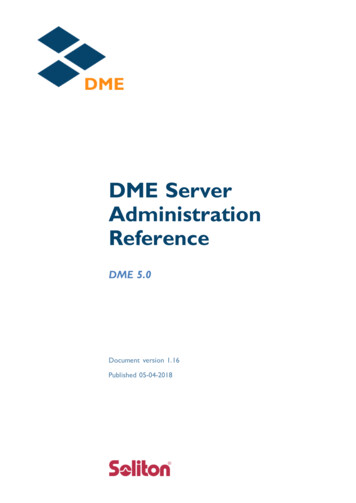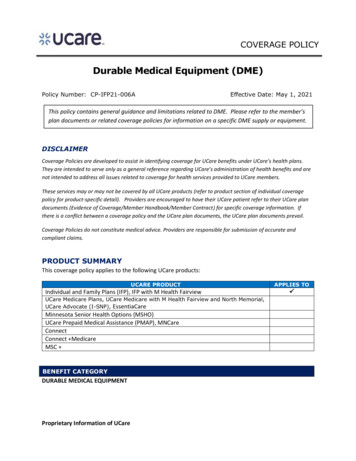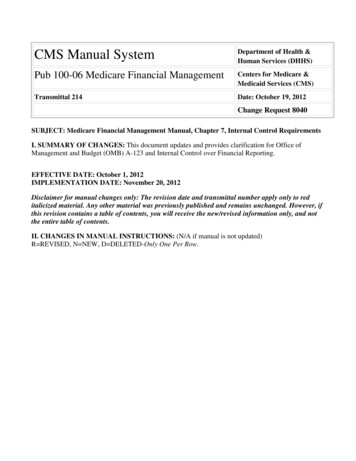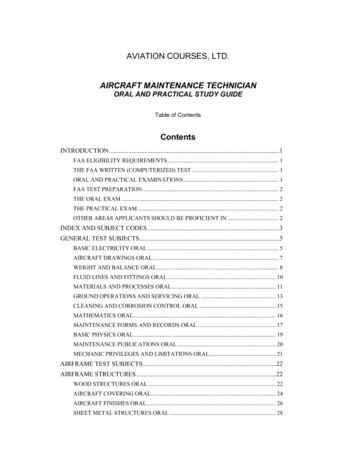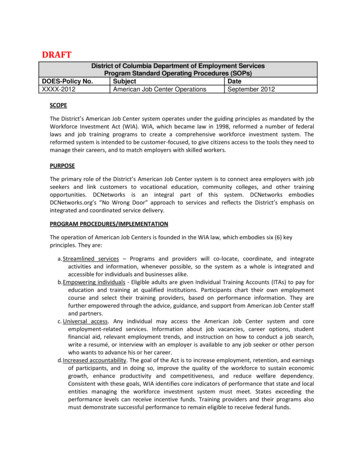
Transcription
DRAFTDistrict of Columbia Department of Employment ServicesProgram Standard Operating Procedures (SOPs)DOES-Policy No.SubjectDateXXXX-2012American Job Center OperationsSeptember 2012SCOPEThe District’s American Job Center system operates under the guiding principles as mandated by theWorkforce Investment Act (WIA). WIA, which became law in 1998, reformed a number of federallaws and job training programs to create a comprehensive workforce investment system. Thereformed system is intended to be customer-focused, to give citizens access to the tools they need tomanage their careers, and to match employers with skilled workers.PURPOSEThe primary role of the District’s American Job Center system is to connect area employers with jobseekers and link customers to vocational education, community colleges, and other trainingopportunities. DCNetworks is an integral part of this system. DCNetworks embodiesDCNetworks.org’s “No Wrong Door” approach to services and reflects the District’s emphasis onintegrated and coordinated service delivery.PROGRAM PROCEDURES/IMPLEMENTATIONThe operation of American Job Centers is founded in the WIA law, which embodies six (6) keyprinciples. They are:a. Streamlined services – Programs and providers will co-locate, coordinate, and integrateactivities and information, whenever possible, so the system as a whole is integrated andaccessible for individuals and businesses alike.b. Empowering individuals - Eligible adults are given Individual Training Accounts (ITAs) to pay foreducation and training at qualified institutions. Participants chart their own employmentcourse and select their training providers, based on performance information. They arefurther empowered through the advice, guidance, and support from American Job Center staffand partners.c. Universal access. Any individual may access the American Job Center system and coreemployment-related services. Information about job vacancies, career options, studentfinancial aid, relevant employment trends, and instruction on how to conduct a job search,write a resumé, or interview with an employer is available to any job seeker or other personwho wants to advance his or her career.d. Increased accountability. The goal of the Act is to increase employment, retention, and earningsof participants, and in doing so, improve the quality of the workforce to sustain economicgrowth, enhance productivity and competitiveness, and reduce welfare dependency.Consistent with these goals, WIA identifies core indicators of performance that state and localentities managing the workforce investment system must meet. States exceeding theperformance levels can receive incentive funds. Training providers and their programs alsomust demonstrate successful performance to remain eligible to receive federal funds.
e. Strong role for local workforce investment boards and the private sector. With leadership fromlocal business leaders, the workforce investment board is focused on strategic planning, policydevelopment, and oversight of the local workforce development system. Business and laborhave an immediate and direct stake in the quality of the workforce investment system. Theiractive involvement is critical to the provision of essential data on what skills are in demand,what jobs are available, what career fields are expanding, and the identification anddevelopment of programs that best meet local employer needs.f. State and local flexibility. States and localities have increased flexibility, with significantauthority reserved for the Governor (Mayor) and elected officials, to build on existing reformsand tailor programs to meet the particular needs of local and regional labor markets.Management Roles and ResponsibilitiesAmerican Job Center managers are to ensure that staffing specialists are trained and possess thetools, information, and abilities to use DCNetworks effectively and efficiently. Procedures include,but are not limited to:a. Entering customer data in a timely mannerb. Determining customer eligibility for each service/titlec. Communicating with customers and training providers, including notification of approval tostart trainingd. Preparing various administrative documentse. Recording case notes and comments, as activities occurf. Obtaining copies and recording certificates or documentation of achievementg. Following up on customers to make sure their experience with DOES is satisfactoryh. Assisting customers in finding suitable and self-sustaining employmentDOES employees should refer to the DCNetworks User Manual which provides specific and detailedprocedures on customer entry and case management responsibilities. The manual can be accessedin DCNetworks via the Staff On-Line Reference Link.Universal AccessUnder WIA, all individuals are entitled to a range of “core” services, which are defined as servicesavailable to adults or dislocated workers through the American Job Center delivery system. At aminimum, core services must include:a.b.c.d.e.Eligibility determinations;Intake (which may include worker profiling) and orientation to other services availablethrough the American Job Center system;Initial assessment of skill levels, aptitudes, abilities, and supportive service needs;Job search and placement assistance, and where appropriate, career counseling;employment statistics information, including accurate information on local, regional, andnational labor market areas;Performance information and program costs for training provider services, includingproviders of adult education, post-secondary vocational education activities, vocationaleducation activities to school dropouts, and vocational rehabilitation program activities;
f.g.h.i.j.Information about local workforce investment system performance and any additionalperformance information with respect to the American Job Center delivery system in thelocal area;Accurate information related to the availability of supportive services in the local area,including child care and transportation, and referral to such services, as appropriate;Information regarding filing claims for unemployment compensation;Assistance in establishing eligibility for welfare-to-work activities and financial aid fortraining and education programs not funded under WIA; andFollow-up services, including counseling regarding the workplace, for participants inworkforce investment activities placed in unsubsidized employment for not less than 12months after the first day of the employment, as appropriate.Integrated ServiceAmerican Job Center services are offered with the participation and cooperation of a number ofpartners. In addition to federally mandated partners, such as Veterans Employment Services and TitleV Older Worker programs, District American Job Center partners include community and technicalcolleges, secondary educational institutions, vocational rehabilitation, public assistance, social service,and economic development agencies, as well as community- and faith-based organizations. Whereverpossible, programs and providers are to co-locate, coordinate, and integrate activities and informationso that services are synchronized and accessible for individuals and businesses alike.DOES integrated service is guided by four (4) primary workforce functions:a.b.c.d.The Unemployment Insurance system – the payment of benefits to eligible individuals andthe collection of employer taxes.The Wagner-Peyser Job Service – a publicly funded labor exchange system that matches jobseekers with job openings.The adult programs – providing training to dislocated workers and economicallydisadvantaged individuals with barriers to employment.The Labor Market Information (LMI) system – the gathering and generation of data inaccordance with procedures developed by the USDOL in areas such as employment andwage comparisons, local area employment and unemployment statistics, and high/lowgrowth occupations.DOES engages in the following activities to accomplish its goals and advance the purpose of theAmerican Job Centers:a. Participates in advisory committee and subcommittee activities, including monthly front-linestaff team meetings;b. Develops and operates an integrated case management system;c. Develops and disseminates orientation material that clearly communicates all services tothe public and directs customers to appropriate agency resources;d. Regularly conducts program review and expansion projects, including capacity-buildingactivities;e. Employs a strategic customer satisfaction/improvement plan; andf. Negotiates Memoranda of Understanding (MOUs) and monitors performance by eachAmerican Job Center partner.
Customer ChoiceInformed customer choice is a fundamental principle of the WIA. American Job Centers provideinformation about jobs and job requirements and the training needed to prepare for employment inan occupational area of choice. DOES maintains a list of qualified and certified training providersoffering a variety of educational and occupational programs. Employment specialists guide customersthrough core and intensive services and help them select an appropriate academic or vocationaltraining facility or professional.After receiving core and intensive services and completing an on-line training eligibility application inconsultation with employment specialists, eligible participants use the DCNetworks system to access alist of eligible providers and educational services. The site provides geographically-based informationon:a.b.c.d.Training Providers and Schools – users select this option to link to web sites and to locatespecific providers and schools and the programs offered;Training Education Programs – users select this option to find training or educationalprograms related to an occupation or field of interest;Education Program Completers – this option allows users to review the number of studentsthat complete training and education programs; andFinancial Aid for Training – this option provides potential sources of financial assistance forschools and programs.Priority of ServiceThe Workforce Investment Act states that, in the event funds allocated to a local area for adultemployment and training activities are limited, priority for intensive and training services under Title IAdult funds must be given to recipients of public assistance and other low-income individuals in thelocal area. Federal priority of service guidelines apply to Title I Adult funds only. Funds allocated fordislocated workers are not subject to this requirement (20 CFR 663.610).The following policies will be applied District-wide for the use of Title I Adult funds under the WIA:a.b.c.d.When Title I funds to serve adults are determined to be limited, priority for services must begiven to recipients of public assistance and other low-income adults as set forth in Section101(25) of the Act;When American Job Center managers accept all customers, priority will be given to Districtresidents or those dislocated from an employer in the District of Columbia;The Priority of Service policy does not prohibit American Job Centers from providingintensive services to individuals other than District residents; andResidency may not be used for priority of service regarding core services. Core services shallbe universally available to all adults and dislocated workers regardless of where they live.ACTION: This is the official District policy and should be kept in your permanent policy issuance file.Share this information with your staff and anyone else who would benefit from these policies.
APPROVALDirector’s SignatureDateLisa María MalloryRemove & Destroy:Effective Date:Review Date:Distribution:NoneDate of SignatureTwo-Year Anniversary of SignatureAll DOES American Jobs Center Employees, Office of Program PerformanceMonitoring Employees, and the District Eligible Training ProvidersPoint-of-Contact:American Job Center, 202-698-4215
local business leaders, the workforce investment board is focused on strategic planning, policy development, and oversight of the local workforce development system. Business and labor have an immediate and direct stake in the quality of the workforce investment system. Their

